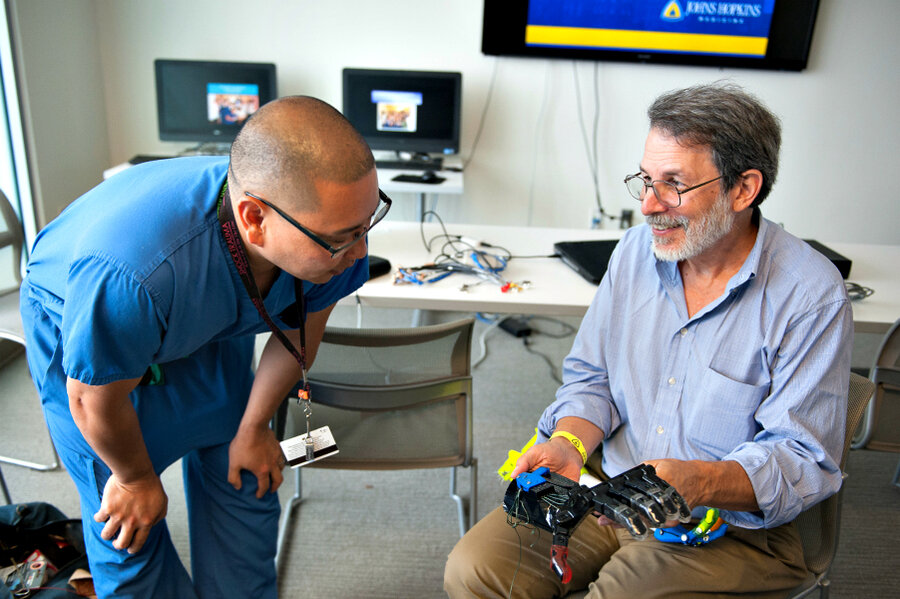Jon Schull brings do-it-yourself artificial hands to the masses
Loading...
Jon Schull is smiling. He’s standing in a packed Las Vegas hotel auditorium in front of an audience gathered for the Intel Corporation International Sales and Marketing Conference in February.
But his casual attitude feels more appropriate for a professor chatting with students during office hours. Hands placed in his pockets, he shifts his weight from one foot to another, before speaking. Then he launches into a description of e-NABLE, the online community he formed a year ago to teach people how to make prosthetic hands using 3D printers.
A young man named Peregrine Hawthorne joins Mr. Schull onstage. On his left wrist he wears a mechanical hand. He began building the hand with his dad about nine months ago on a 3D printer. He slips the hand on and off. He flexes its fingers back and forth. Easy as that.
Prosthetic hands purchased from manufacturers typically cost from $10,000 to $80,000. This one cost about $50. As Mr. Hawthorne uses it, the crowd cheers. Off to the side stands Schull, beaming.
Schull started thinking about prosthetics two years ago. He was at a conference of the National Collegiate Inventors and Innovators Alliance, a nonprofit group that funds student projects aimed at social change. There, he heard from students who had helped design prosthetics for people in need. He was impressed with what they had done.
Schull wondered: How could he bring prosthetics to the masses?
As a professor at the Rochester (N.Y.) Institute of Technology specializing in innovation and collaborative technology, his mind jumped to 3D printers and the world of open-source software. A software developer, for example, who uses open-source code just downloads it for free.
There had to be a way to do the same thing with prosthetics, he thought.
A year went by. He began to think his idea too was grandiose, incapable of becoming a reality. And then he came across a YouTube video that showed how a South African carpenter named Richard Van As had worked with a US special effects artist and puppeteer named Ivan Owen to create a 3D-printed device for people who were missing fingers. “Just in passing, he mentioned that he was going to make the design available open source,” Schull says.
He got excited: Here was someone who shared his vision. He read the comments posted to the video. Others shared his enthusiasm for affordable prosthetic limbs.
Schull realized this was an opportunity to distribute a workable design for a 3D-printed hand online. People could teach themselves how to make the devices. “People were saying, ‘This is really cool. I have a 3D printer. I would make a hand for a kid who needed one,’ ” he says.
Schull made a Google map and invited people who’d commented on the video to put themselves on it. After six weeks about 70 people were on the map.
The project continued to grow, and Schull stepped into the role of facilitator. He connected people with people, acting as the spark to turn an online forum into a laboratory for innovation.
“I’ve become a professional matchmaker,” he says, chuckling.
Some people wanted to make prosthetics for themselves or a loved one. Others had the technology and a desire to help. The group was dubbed e-NABLE. Soon it added a website, a Facebook page, and a Google+ community that now has more than 1,000 members.
People who want to get involved contact the group. From there, a volunteer replies. The volunteers either offer instructions on how to make a prosthetic hand or connect the inquirer to people who have 3D printers and want to help.
“We’re not actually supplying prosthetics,” Schull says. “We’re helping people figure out how to solve these problems, and volunteers are there to make it fun and interesting and satisfying for them.”
For once, Schull is finding that his ideas aren’t too “out there”: He’s right in line with the do-it-yourself revolution.
“I’ve made a career out of pushing forward what seem like good ideas, many of which were ahead of their time or good solutions for a parallel universe,” he says. “But this one has really taken off rather as advertised.”
As e-NABLE grows, Schull is acquiring a steady following.
“He’s very brilliant. He’s passionate about what he does,” says Nathan Ramsey, an occupational therapist who works with e-NABLE giving feedback on hand designs and establishing safety guidelines. “He’s got a big, big heart, and he’s make a big difference with what he’s doing.”
“This is setting a precedent,” says Hawthorne, who appeared onstage with Schull in Las Vegas. “You don’t have to have some big company. You don’t have to be driven by profits.... People can just come together with a common ideal and make something happen out of it.”
• For more visit www.enablingthefuture.org or www.facebook.com/enableorganization.







